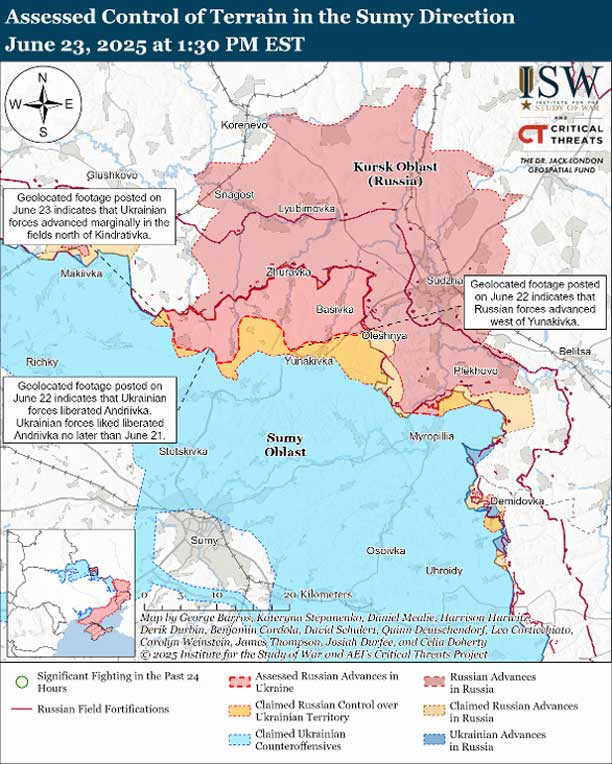| « How Democrats’ 15-Year Fake Culture War Created Trump—And Made His Worst Excesses Inevitable | Criminals, Cartels, and Corporations: The 20 Worst Pillagers of the Amazon & Orinoco » |
Russian Ukraine War Summer 2025 Update
Fred Gransville
1. Russian Summer Offensive Advances on Multiple Axes
- Cutting-edge drone warfare
Russia is deploying "unjammable" fiber-optic–linked drones across Donbas, Sumy, and Kharkiv, allowing coordinated tactical advances. These UAVs have enabled Russia's most significant gains since late 2024-placing towns like Kostiantynivka under renewed pressure and threatening key Ukrainian supply routes arabnews.com+2ft.com+2the-sun.com+2. - Incremental territorial gains
Though gains remain modest-averaging ~50 m per day-the seizure of key villages in Sumy, Kharkiv, and Donetsk creates new forward positions that complicate Ukrainian defense nzherald.co.nz+15csis.org+15washingtonpost.com+15.
Frontline Status Overview – June 2025
| Region | Combatant Activity | Outcome / Shift |
|---|---|---|
| Donbas (Chasiv Yar, Avdiivka) | Russian drone-backed infantry pushes; Ukraine holds defensive trenches | Stalemate, high attrition |
| Kharkiv (Vovchansk, Lyptsi) | Multi-pronged Russian advance toward border towns | Partial Russian control; Ukraine regrouping |
| Sumy Region (Kostiantynivka) | Buffer-zone incursion; Russia attempts corridor | ~20 km breach into Ukrainian territory |
| Zaporizhzhia Front | Heavy shelling from both sides | No strategic changes; drone reconnaissance dominates |
| Ukrainian Interior (Kyiv, Odesa) | Russian cruise missile and drone strikes | Civilian infrastructure damaged, morale tested |
Strategic & Diplomatic Status Matrix
| Domain | June 2025 Snapshot | Trend |
|---|---|---|
| Military Aid | $61B U.S. delayed package trickling in; Czech/EU production rising | Still behind demand |
| Drone Warfare | Russia leads with fiber-optic drones; Ukraine retaliates with deep strikes | ⬆ Technological escalation |
| Diplomacy | POW swaps continue; Russia offers post-summit dialogue | Tense, semi-active channels |
| Global Geopolitics | Middle East tensions feed oil price surge; NATO cohesion tested | ⬇ Western unity at risk |
2. Ukraine’s Defense: Counterstrikes & Strategic Strain
- Ukrainian drone and airbase strikes
Kyiv conducted Operation “Spiderweb” on June 1, reportedly destroying 41 Russian bombers-including long-range Tu‑95s-at deep airbases nzherald.co.nz+2the-sun.com+2presstv.ir+2nzherald.co.nz+1france24.com+1. Arab News quotes Gen. Syrsky affirming expanded precision strikes deep into Russian-held territory france24.com+3arabnews.com+3arabnews.com+3. - Persistent ammunition shortages
Multiple outlets-including Iran’s PressTV and Arab News-report Ukraine struggling with artillery and ammo shortages, prompting increased domestic and Czech production initiatives .
3. Frontline Hardship & Civilian Toll
- Heavy Russian strikes across cities
French‑language outlets (France 24) and Arab News describe sustained waves of Russian drone, missile, and artillery barrages targeting Kyiv, Kharkiv, Odesa and Dnipro, causing civilian casualties and infrastructure damage arabnews.com+2france24.com+2france24.com+2. - Humanitarian and military impact
Reports from Arab News on June 24 cite at least 18 civilian deaths and over 100 injuries from assorted drone and missile strikes-prompting Zelensky to reiterate urgent aid appeals dailytelegraph.com.au+15arabnews.com+15washingtonpost.com+15.
4. Logistics, Aid & Defense Industry Response
- Munitions production ramp-up
NATO allies are increasing local munitions manufacturing-UK’s BAE Systems, Czech programs-but report that production still falls short of battlefield demands nzherald.co.nz. - Global alliance fracturing
New Zealand has pledged modest funding ($16 m) despite efforts to remain "neutral," while Arab and PressTV sources highlight deepening strain in trans-Atlantic unity as U.S. and European aid lags apnews.com+2arabnews.com+2apnews.com+2.
5. Prisoner Exchanges & Diplomatic Signals
- Regular POW swaps
Multiple regions report routine exchanges of hundreds of POWs-e.g., 1,000 soldiers in mid-June following Istanbul peace talks. Zelenskiy confirmed return of 1,200 bodies from Russia theguardian.com+4arabnews.com+4france24.com+4. - Talks and diplomatic brinkmanship
France 24 notes stalled "memorandum" talks since early June. Russia signaled openness to a Putin–Zelenskiy meeting post‑June 22 summit, though would insist on preconditions cementing Kyiv’s neutrality and territorial concessions washingtonpost.com.
6. Geopolitical Pressure & Middle East Linkages
- Russia–Iran’s ambiguous alliance
U.S. think tanks and PressTV report Russia’s alliance with Iran remains largely rhetorical. Moscow continues diplomatic backing while avoiding deeper military entanglement understandingwar.org+1thecipherbrief.com+1. - Global ripple effects
Chinese and NZ media warn that Middle East tensions (e.g., Iran's missile barrages against Israel) are raising oil prices, boosting Russian revenues, and potentially undermining Ukraine by diverting Western focus youtube.comtheguardian.com+2apnews.com+2wsws.org+2.
Big Picture
|
Dimension |
Status & Implications |
|
Russian Offensive |
Rapid multi-axis drone-assisted push; modest but worrisome territorial pressure in Sumy, Kharkiv, and Donetsk regions |
|
Ukrainian Defense |
Resilient yet resource-starved; deep strikes (Spiderweb) shake Russian military infrastructure |
|
Civilian Costs |
Heavy toll from Russian air campaigns; growing international concern over humanitarian impact |
|
Allied Support |
Increasing munitions efforts overshadowed by supply delays and political tension within alliances |
|
Diplomatic Landscape |
Sustained prisoner swaps signal channels remain open, but core peace negotiations remain deadlocked |
|
Geopolitical Complexity |
Middle East turmoil bolsters Russian finances; Russia–Iran ties remain cautious and pragmatic |
Fiber optic drones are unique FPV drones whose communication is achieved through a fiber optic cable instead of common radio waves. With the tethered connection, they are extremely secure against jamming and detection by enemy electronic warfare systems. They are most appropriate for reconnaissance and precision strikes, especially where regular drones will be useless.
Key Features and Benefits:
Tethered Communication:
Rather than depending on radio signals, fiber optic drones use a thin, light fiber optic cable that unspools as the drone is in flight to connect to their operators.
Immunity to Jamming:
Since there are no radio signals, they cannot be detected by conventional electronic eavesdropping and are resistant to jamming attempts.
Clear Video Feed:
The fiber optic cable provides a stable and secure connection, resulting in high-quality, real-time video transmission.
Enhanced Precision:
The clarity of the video feed allows for more accurate targeting and payload delivery.
Stealth:
The lack of radio signals makes them difficult to detect, offering a stealth advantage.
Versatility:
Fiber optic drones may be utilized for various kinds of missions like surveillance, reconnaissance, as well as precision strikes.
How it Works:
A fiber optic drone is essentially a regular FPV drone with a spool of fiber optic cable strapped to it. During flight, the cable is unwound, maintaining itself attached to the ground operator at all times. Video transmission and control signals go through the cable, rather than radio frequencies.
Impact on Warfare:
Lesser Vulnerability:
Fiber optic drones are significantly less vulnerable to electronic warfare tactics, giving them a crucial advantage on the battlefield.
Changing Battlefield Dynamics:
The use of fiber optic drones is shifting the balance of power in conflicts, particularly in situations where electronic warfare is prevalent.
Increased Precision:
The ability to transmit crisp and clear video signals and maintain a stable connection allows more precise targeting and strikes.
Current Usage:
Fiber optic drones are currently being utilized in the Russia-Ukraine conflict with both sides developing and using these drones. The technology is rapidly advancing with continuous upgrades in range, payload capacity, and counter-measure resistance
The war in Ukraine has entered a phase defined by technological escalation, asymmetric momentum, and geopolitical fragmentation. As the charts illustrate, Russia’s drone-assisted offensives in Kharkiv and Sumy have breached strategic zones, while Ukrainian defenses remain firm but stretched thin. Kyiv’s capacity to strike deep into Russia has rattled Moscow but has not reversed territorial trends.
Meanwhile, critical delays in Western aid and fractured NATO commitment contrast sharply with Russia’s streamlined battlefield adaptations and diplomatic entrenchment. The prisoner exchanges and muted diplomatic gestures offer flickers of engagement, yet neither side shows readiness for substantive peace. The broader context-marked by Middle Eastern volatility and shifting global alignments-further complicates a conflict increasingly shaped not just by weapons or will, but by the fracturing of the global order itself.
-###-
'Russian Ukraine War Summer 2025 Update' by Fred Gransville




